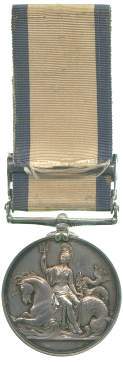Current Location: In storage
Maker(s)
Mint:
London
Ruler:
Victoria (1837-1901)
Artist:
Wyon, William
Ruler:
Victoria regina
(With the title of)
Entities
Categories
Description
Just as in 1848 the extensive land campaigns of the Napoleonic Wars and the other conflicts of the pre-Victorian era were recognised by the issue of the Military General Service Medal, those serving in the Navy at the time were recognised with the Naval General Service Medal. As with the Army equivalent and the East India Company's related award, many of the battles for which the medal was awarded had been fought so long ago that few if any claimants survived.
In addition, bars were awarded for many actions whose significance and size were, despite the heroism displayed by those involved, relatively minor. The result was that many of the bars were issued in tiny numbers, with some combinations all but unique, and the medals command a very high price among collectors because of this rarity and individuality. This in turn, along with the manufacture in most cases of more bars than were eventually issued, has led to the `improvement' of many common awards where recipients' names are shared with those present at `rarer' battles. The medal also shares with the Military General Service and Army of India Medals the oddity that Queen Victoria, whose portrait they bear, was not the ruler under whom the battles for which it was awarded were fought.
Thus only 21 bars were awarded for Lion 15th July 1798, an encounter in which HMS Lion engaged a force of four Spanish vessels off Cartagena alone and captured the Spanish frigate Santa Dorotea, even though as a 64-gun third rate she carried a crew of at least 500. Lion's career had already seen her in two other bar-winning battles at this point, and she would serve until the end of the Napoleonic Wars.
This medal was awarded to Henry Boyes, who had joined the Navy in 1796 and was therefore probably a Midshipman when aboard the Lion in 1798. By 1809 he had been promoted Lieutenant and was serving aboard the 120-gun first-rate battleship HMS Caledonia. Caledonia, brand new and the largest ship in the Navy, was the flagship of Lord Admiral James Gambier on 12 April 1809 when one of his subordinates, Captain Thomas Cochrane, organised a fireship attack on a French fleet lying off St Nazaire, where it threatened British attempts to renew fighting in the Iberian Peninsula. The attack caused great controversy, as although Cochrane's part of the attack, involving bomb vessels, threw the French fleet into near total disarray despite their being aware of the British plan, the fireships missed their target and Gambier kept his fleet clear of the battle zone, thus meaning that Cochrane had only his own frigate to take advantage of the French panic, in which many of their ships ran aground. In later years Cochrane challenged Gambier over his diffidence in attack, and Gambier was exonerated by court martial leading to Cochrane's removal from the Navy. A balanced account of the true course of the battle is difficult to extract, but it is worth noting that Napoleon himself said of the attack, "Lord Cochrane could not only have destroyed [the French ships], but he might and would have taken them out had your Admiral supported him as he ought to have done" (B. E. O'Meara, Napoleon in Exile, or, A Voice from St Helena: the opinions and reflections of Napoleon on the most important events of his life and government in his own words (London 1821)).
The last bar on the medal relates to another exploit during Boyes's time in Caledonia, in which boats from her and two other vessels rowed into the Basque Roads, which the French were still using as an anchorage, on 27 September 1810 and captured a pair of French brigs off Pointe du Ché.
This was far from the end of Boyes's career; the Medals Roll confirms the issue of these bars to him, and also adds the detail that in 1842, by now a Captain, he was fighting in China and thus eligible for the First China War Medal. Lester Watson acquired his NGS Medal from the London dealers Baldwin in 1928. It had arrived with them from the auction of the Hamilton-Smith Collection by Glendining (21-22 Nov. 1927, lot 1133), and had come to Hamilton-Smith from the Payne Collection in 1911.
Notes
History note: Gift of L. Hoyt Watson; ex Lester Watson Collection, bt Baldwin 1928. Ex Hamilton-Smith Collections (21-22 Nov. 1927, lot 1133), ex Payne 1911.
Legal notes
Given by Lester Watson through Cambridge in America, 2009
Measurements and weight
Diameter: 36.1 mm
Weight: 38.6 g
Acquisition and important dates
Method of acquisition: Given
(2009)
by
Watson, Lester
Dating
1849
-
1851
Materials used in production
Silver
Techniques used in production
Struck
Inscription or legends present
Inscription present: Bust of Victoria facing left
- Text: VICTORIA REGINA
- Location: Obverse
- Type: Design
Inscription present: Britannia with trident seated sideways on seahorse
- Location: Reverse
- Type: Design
References and bibliographic entries
Identification numbers
Accession number: CM.1356-2009
Primary reference Number: 141450
Watson Catalogue: 262
Ordering: M-0239
Previous object number: LW.0239
Stable URI
Audit data
Created: Saturday 6 August 2011
Updated: Monday 25 March 2024
Last processed: Wednesday 14 May 2025
Associated departments & institutions
Owner or interested party:
The Fitzwilliam Museum
Associated department:
Coins and Medals





